
How to Ship a Revel
The years spent dreaming and planning for this around-the-world adventure were long, filled with research and eager anticipation. But the past month leading up to our launch date was brutally short, and I was swept away by a landslide of logistics: plane tickets, paperwork, hotel reservations, car rentals, deadlines. En masse, the cascade of tasks was daunting. In reality, each item was familiar and manageable.
Shipping our van from the United States to Europe was a completely different matter, a foreign and seemingly impossible mission, where even identifying the process itself seemed an unruly conundrum. I looked to friends for personal insight and experience in such affairs, and perused the internet, filtering through endless firsthand accounts (often with horrific outcomes), checklists, and how-to articles in hopes of deciphering the shipping process.
Options for Shipping our RV to Europe
The first decision was relatively straightforward: RORO or container. There are three ways that you can ship a vehicle, each with their distinct advantages and disadvantages. The first is RORO (roll-on, roll-off) where you deliver a fully functional vehicle, void of any personal effects to the shipyard, and rely on deckhands to drive your vehicle on and off what is essentially a floating, enclosed parking garage. While this is the least expensive option, it carries the greatest risk in that anyone within the port or on the ship will have complete access to your vehicle throughout the voyage, leaving ample opportunity for both theft and damage.
The second method of shipping is via a sealed container. While this is a more costly option, there are two distinct benefits. In addition to the vehicle, the container can be packed to the brim with personal effects, and the container itself is sealed and secure from the point of drop-off to pick-up, preventing any pilfering and minimizing the potential for damage.
The third option is a hybrid of sorts, where a vehicle is shipped in an open container along with any other items on what is essentially a gigantic, open-sided pallet, which is then hoisted onto the ship in the same manner as a closed container. This method is expensive and less secure and is often used for oversized vehicles that do not fit inside a container and cannot be driven on or off the ship. Because our Winnebago Revel measures in at almost nine feet in height, eliminating even a tall container as an option, we elected to go with RORO.
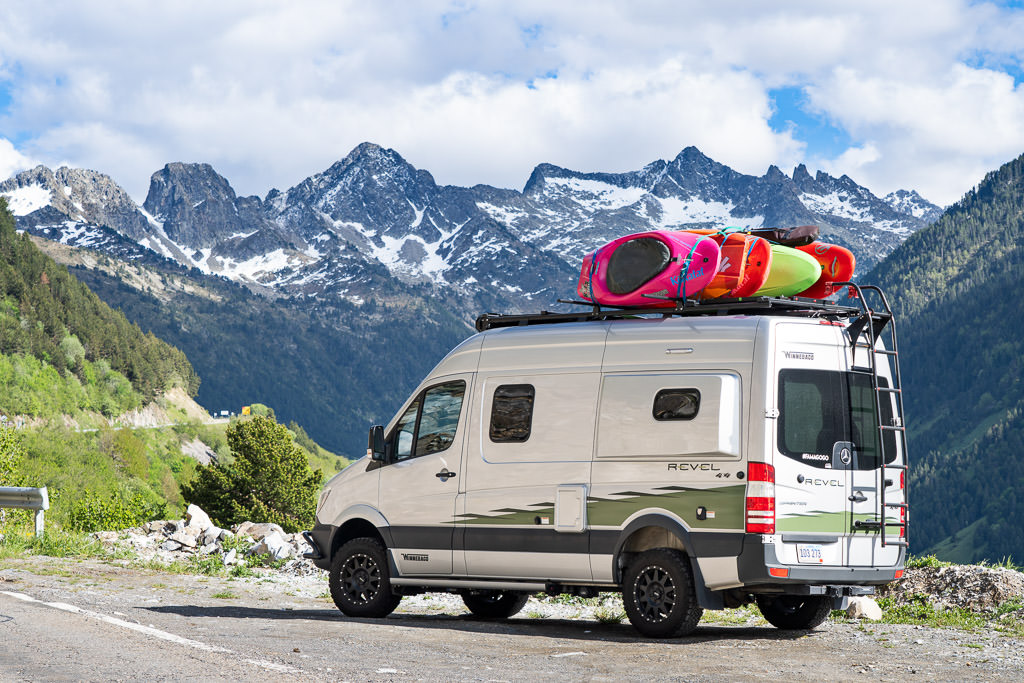
Booking the Passage (with Help)
The next step was to book passage on a ship, and this is where everything became a bit more complicated. It seems that it would be a relatively simple process: do a Google search for vehicle transport companies, send an email query for a quote, and then choose the best price, route, etcetera. And in keeping true to our do-it-yourself nature, we initially thought that shipping a vehicle would follow the same familiar path of research, falter and regroup. However, our preliminary internet inquiries revealed an endless rabbit hole of online anecdotes of one horrible shipping fiasco after another. Some adventurers had been waylaid in ports for weeks on end, making a daily pilgrimage to the local customs office in hopes that they would eventually retrieve their vehicle. This left us wondering if it was worth it to ship a van at all. Rather than completely throwing in the towel to a longtime dream, we elected to forego the DIY approach and reached out to a multitude of shipping brokers to walk us through the process.
The list of shipping companies is immense, and it is difficult to distinguish which companies are the actual shippers and which are merely brokers acting as an intermediary between the transport company and the customer. Sorting through the lot was no small feat. I created an email query template that included our vehicle dimensions, weight, the ideal date range for transport, and rough departure and arrival locations. I then requested information on recommended routes from the USA to Europe and their respective rates, sending it to anyone with a reasonably navigable website. Out of 25 queries, only four companies responded at all, and only two replied with route information and corresponding rates: IVSS and Ship Overseas. I did follow up with the other two asking for rates, never heard back from them, and crossed them off of the list of possibilities. With only two real options to choose from, it simply became a matter of service, price, and route availability.
Both companies proved to have exemplary customer service, and both were patient and informative when it came to my never-ending litany of questions. They provided comparable quotes from the USA to Europe (approximately $2,700), and both offered the standard list of departure ports from the USA: Houston/Galveston, Texas; Jacksonville, Florida; Brunswick, Georgia; Charleston, South Carolina; Baltimore, Maryland; Newark, New Jersey; Tacoma, Washington, and Long Beach, California. (Side note: the West Coast locations were more than twice the price of the other ports.)
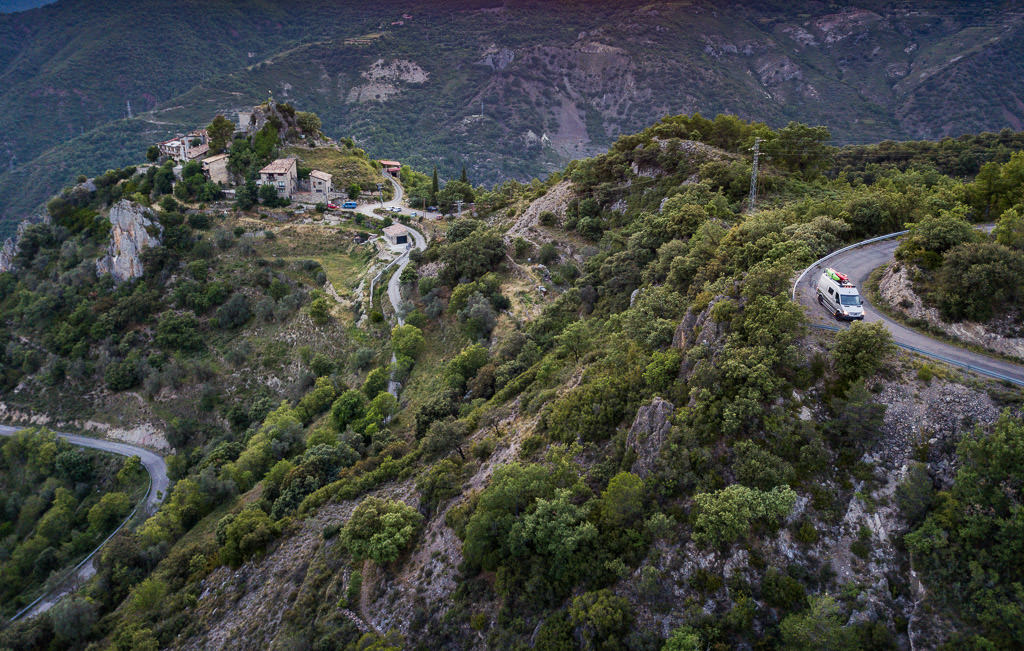
While our general trajectory through Europe is fluid, our starting point was not. We had to be in the mountains of Spain on June 9, and with that in mind, I requested route information to ship directly to Spain. This is where the discrepancy between the two companies emerged. Ship Overseas was incredibly accommodating and quickly provided route and rate information from New York to Barcelona, while IVSS replied that they did not offer shipping services to Spain. As a courtesy to IVSS for their willingness to hold my hand and educate me about the intricacies of shipping a vehicle, I sent an email thanking them for their time and let them know that we were electing to go with another company who was able to accommodate our route preferences. I immediately received a phone call from IVSS HQ, who explained that while they could arrange transport to Spain, they would not because of past experiences with less than optimal outcomes. They further noted that Baltimore, Maryland, is currently the easiest exit point for the USA and that Zeebrugge, Belgium, is one of the easiest entry points for Europe. The ease of entry would more than makeup for the 16-hour drive south from Belgium to Spain. This insight into the nuances of vehicle transport was exactly what I was looking for in a broker, and I booked with IVSS on the spot.
I sent them our vehicle dimensions, title, registration and VIN number, copies of our passports and driver's licenses, and chose a departure date. That's pretty much the whole process, and payment was not due until our van was en route to Europe. I have to admit that it was a bit unsettling how easy it had been thus far, and couldn't help but wonder when the imminent disaster would strike.
In the weeks leading up to our departure date, our broker reached out with updates and recommendations for auto insurance in Europe. Liability insurance is required and available for approximately $100/month, and comprehensive insurance is recommended (but optional), and is outrageously expensive at over $1,000/month. It is unavailable for vehicles valued over 75,000, which eliminated that as an option for our vehicle. We purchased liability insurance and forwarded our certificate of coverage to IVSS to include with our import documentation but (as of the date of publication) are still working on figuring out a realistic and viable option for comprehensive coverage.
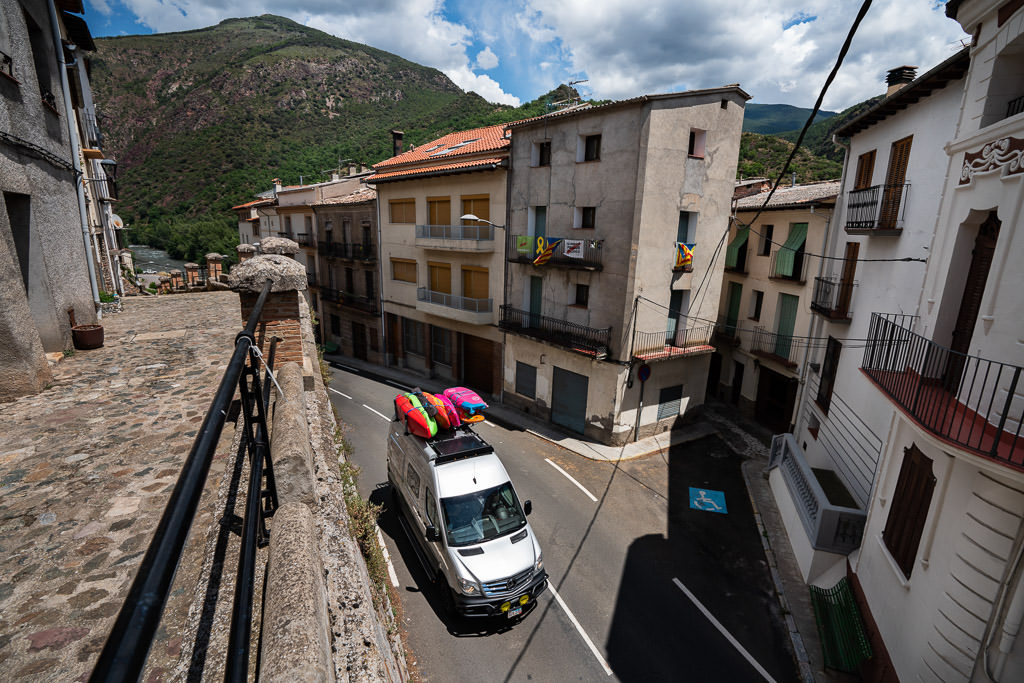
Rundown of the costs associated with shipping the Revel:
- Shipping and Import/Export Fees: $1,900
- Export Duties: $40
- Import Fees: €300
- Shipping Insurance (optional and based on the value of your vehicle): 0.9% value of the vehicle
- Liability Insurance (required for entry into Europe): €742
- Port Escort in Baltimore:$50
Sending the Revel on its Voyage
Three days before our scheduled departure date, I received a final checklist with a few last-minute instructions about the drop-off location and an emphatic reiteration on how important it was to arrive at the port on time, with a clean and empty vehicle. We'd followed their recommendations explicitly with one notable exception. There simply wasn't room to fly with many of the items we needed during our six months in Europe, so we decided to ignore the request for an empty vehicle, and instead stowed dishes, bedding, tools, silverware, towels, camp chairs, first aid kit, and two large kayaks securely inside our Revel. It was a gamble as to whether or not our personal effects would disappear during transit or be confiscated by customs, but we elected to roll the dice.
I swung by the IVSS office in Baltimore on my way to the port where they had a hefty packet of paperwork waiting for me. They summoned an official port escort who met me in the parking lot just outside the security checkpoint. My escort turned out to be a soft-spoken gray-haired man who sifted through my documentation, gave a nod of approval, and instructed me to follow behind his van closely and do exactly what he said. I got behind the wheel, and we were off. It was immediately apparent that this was not his first rodeo, as he zigged and zagged between two endless lines of gridlocked semi-trucks. In a flash, we were next in line to enter the port. He raced back to my window and pulled the appropriate document from my paperwork, asked for my passport, and presented it all to the guard, who nodded and raised the gate.
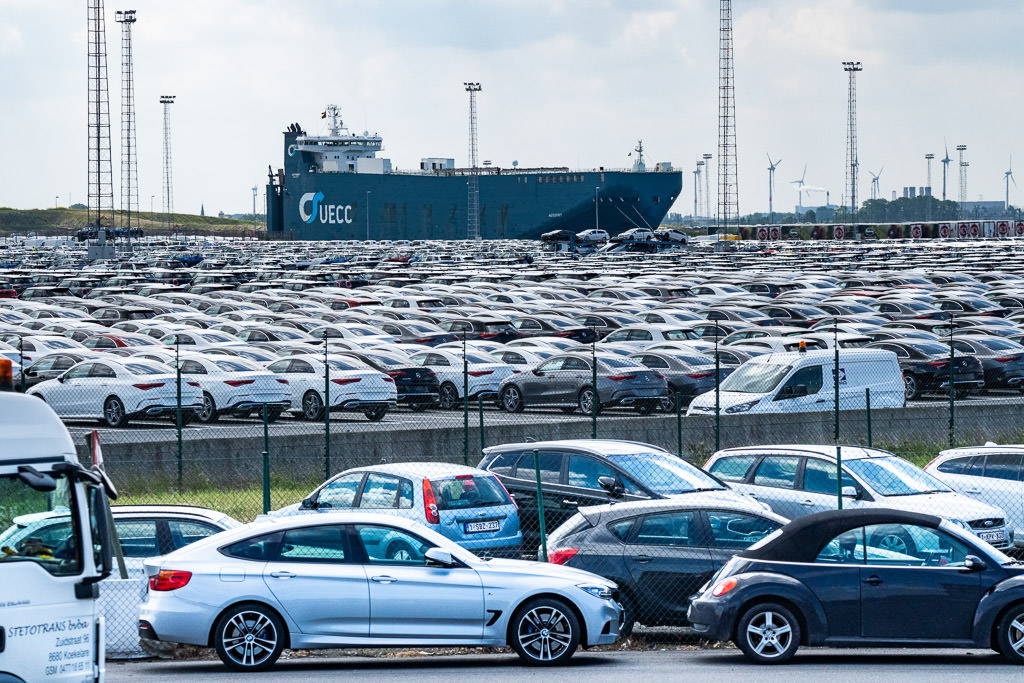
Once inside, there was a lot to take in, and the hustle and commotion of commerce was a bit overwhelming. I drove past 100 John Deere tractors being loaded onto a freighter. There was a parade of Teslas moving toward another area of the port, and an endless line of semis at every junction awaiting their turn to drop off their cargo at each of the colossal container ships that punctuate the perimeter of the port. My escort took me from one checkpoint to the next, at each stop sifting through my documents and selecting the appropriate packet of paper. He subtly made recommendations as to which line to choose (and which teller to avoid) and expedited my progress through the port with incredible efficiency.
Eventually, we came to the end of my documents, and the end of the line. I parked our Revel between another expedition vehicle and a row of farm tractors. I dropped the keys in the cupholder as directed, hopped in the escort vehicle, and exited the port. The entire process took less than an hour.
I left the port relieved that we had made it halfway through the process, but at the same time anxious for what awaited us in Belgium. Could it really be this easy? Would our Revel make it across undamaged? Would our personal effects be there waiting for us? How long would it take to extricate our van from the port in Europe? I forced myself to put aside my doubts and trust that with a little luck, we would pick up our Revel in Belgium, safe and sound, and the process would be just as efficient.
Reuniting with the Revel in Europe!
The next three weeks were a hurricane of chaos filled with packing, flights, hotels, and the excitement that comes with exploring a foreign land. IVSS sent us a link that tracked the progress of the ship so that we could keep an eye on the whereabouts of our van. We were fascinated with how quickly the ship progressed through its journey: three days (plus a three-day holiday weekend) to load the ship in Baltimore, a day to New Jersey, three days in the port in Newark, seven days across the Atlantic, a quick stop in the UK, and then it arrived in Zeebrugge, Belgium.
We were hopeful that we would be able to pick it up the next day, but unfortunately, it arrived on a Friday afternoon. The port was closed for the weekend, and there was a national holiday on Monday -- we spent the long weekend with friends in Brussels and headed to the port early Tuesday morning. This time there was no escort to expedite the process, so we navigated the maze of roads around the port by braille: stopping to ask for directions and struggling with the language barrier. After an hour of wandering, we eventually made it to the proper terminal and checked in at the transport company office.
Through broken English, a gruff clerk informed us that we have arrived during a break and that our Revel will be retrieved when the dockworkers return. We sit outside anxiously for almost an hour and take in the operations of the port. It was very similar to Baltimore, and I suspected that an aerial view would strongly resemble a colony of ants, with a precise progression of a thousand parts moving in unison to support the demands of global commerce. At precisely one hour after our arrival, our van pulled up in front of us, beautifully unscathed. The driver handed us a packet of paperwork and directed us back into the office. We handed over our documents, which received an official stamp, signature, and were returned along with our keys.
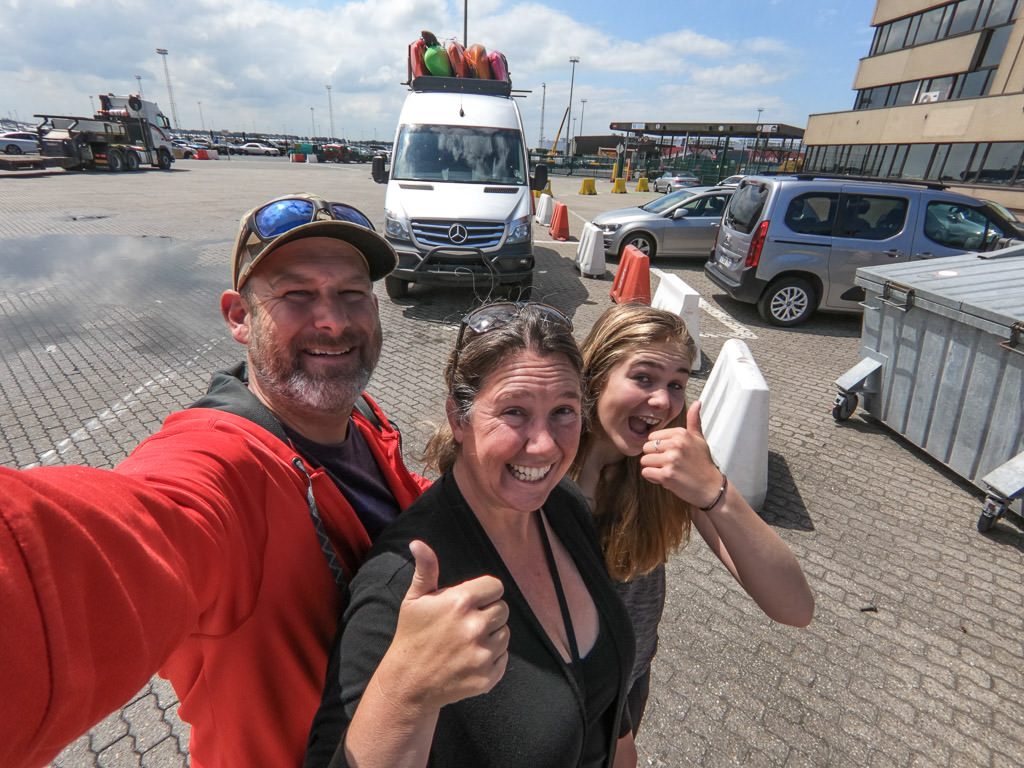
We raced back to our van and carefully inspected every inch, inside and out, finding that it was exactly as we left it. We were giddy with relief and astonished with how easy the entire experience was. Looking back, I can't help but speculate on what would have happened if we had elected to try to navigate the process without the assistance of a shipping broker, or if we had decided to import into Spain instead. It's impossible to know, but I suspect there was a great deal of work behind the scenes to make this first leg of our around-the-world adventure appear seamless and easy.
Our first hop to a new continent has been a resounding success, and for now, we are completely enamored with the people and places we are discovering in the mountains of Spain and France. But the allure of the next destination is ever-present in our minds: maybe South America, maybe Africa or perhaps Australia? Regardless of where we go, IVSS will be our first contact as we begin to wade through the logistics of phase two of the Famagogo world tour.
Editor's Note: The original version of this article was published in Expedition Portal.
Comments
Comments on this post are moderated, so they will not appear instantly. All relevant questions and helpful notes are welcome! If you have a service inquiry or question related to your RV, please reach out to the customer care team directly using the phone numbers or contact form on this page .